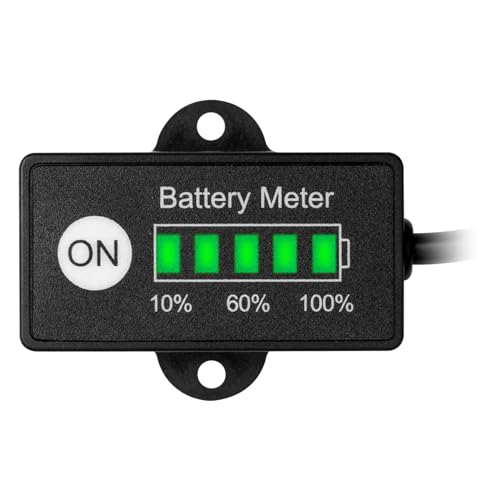We’ve rounded up the five best 12V LiFePO4 batteries for 2025 and paired them with a simple voltage chart to nail state of charge. We’ll cover compact picks with LCDs and rugged BMS protection, plus handy meters that avoid guesswork. We’ll also explain why resting voltage matters more than live-load values and how temperature skews results. If you want reliable capacity without surprises, this shortlist sets you up—now let’s separate the real upgrades from the hype.
Key Takeaways
- Upgraded 12V 22Ah LiFePO4 with LCD and 30A BMS: 5.5 lb, series/parallel up to 4S4P, ideal for portable power; use 14.6V charger.
- Upgraded 12V 15Ah LiFePO4 with LCD and 15A BMS: 3.4 lb, 4000+ cycles, IP65, fast charges ~3 hours; great for kayaks, fridges, UPS.
- TalentCell 12V 6Ah LiFePO4 pack: 3000+ cycles, DC5521 up to 5A, stable 12–13V output; compact travel power for small electronics.
- Multi-voltage LCD meter (12–72V) with low-SOC alarm supports LiFePO4; simple two-wire install; verify max voltage spec before 48V+ use.
- Accurate SOC voltage chart: 4S LiFePO4 rests 12.6–13.0V, full ~14.4V; flat discharge; measure after 1–2 hours rest and consider temperature.
Upgraded 12V 22Ah LiFePO4 Lithium Battery with LCD and 30A BMS
November 19, 2025 10:05 am
Looking for a lightweight, grab-and-go power source for portable rigs? This upgraded 12V 22Ah LiFePO4 packs 5.5 pounds into a 3 x 7.1 x 7-inch shell, with Grade A cells, an LCD voltage display, and a robust 30A BMS. It’s deep-cycle, low self-discharge, and good for 4,000+ cycles—far beyond SLA.
We like the standard M5 terminals and flexible expansion: up to 4 in series and up to 4P4S. It’s compatible with fishfinders, ham radios, camping gear, solar, UPS, and RV electronics, but not as a starter battery. Use a 14.6V LiFePO4 charger. Store at 40–60%, recharge monthly, and disconnect when idle.
Best For: Portable power users—ham radio operators, anglers with fish finders/LiveScope, campers, and off-grid tinkerers—who need a lightweight 12V deep-cycle battery with expansion options and long lifecycle.
Pros:
- Lightweight 5.5 lb form factor with LCD voltage display and 30A BMS for robust protection
- Long life (4,000+ cycles) with Grade A LiFePO4 cells, low self-discharge, and stable performance
- Flexible connectivity: standard M5 terminals; up to 4 in series and 4P4S expansion; solar/UPS/RV/ham/fishfinder compatible
Cons:
- Not suitable as a starter battery for cars, motorcycles, or ATVs
- Requires a dedicated 14.6V LiFePO4 charger (lead-acid chargers not recommended)
- 22Ah capacity may be limiting for high or long-duration loads; larger capacity may be needed for extended use
Upgraded 12V 15Ah LiFePO4 Lithium Battery with Built-in BMS and LCD Meter
November 19, 2025 10:05 am
Prefer a compact, no-fuss power pack with at‑a‑glance status? This 12V 15Ah LiFePO4 battery delivers with a built‑in LCD voltage meter and a 15A BMS. It’s 3.4 lbs—about three times lighter and 30% smaller than AGM—yet offers 4000+ cycles, 98% efficiency, and zero maintenance. Expect fast charging (about three hours with a LiFePO4 charger at 14.2V±0.2V), steady 12V output, and safe operation from -4°F to 140°F. The BMS guards against overcharge, over‑discharge, temperature extremes, and shorts. Ideal for kayak trolling motors, fish finders, cameras, camping lights, fridges, tools, and UPS. Expand to 48V/60Ah with matched units. IP65 for select uses.
Best For: Kayakers, campers, and DIY power users who need a compact, lightweight 12V battery with at‑a‑glance status, fast charging, and reliable deep‑cycle performance for mid‑power gear.
Pros:
- Ultra‑light (3.4 lbs) and 30% smaller than AGM with 4000+ cycles and 98% efficiency
- Built‑in 15A BMS and LCD voltage meter for protection and easy status checks
- Fast charging (~3 hours with LiFePO4 charger) and stable operation from -4°F to 140°F; expandable up to 48V/60Ah
Cons:
- 15A BMS current limit may not suit high‑draw devices without using multiple batteries
- IP65 is application‑dependent; not fully waterproof for submersion
- Requires LiFePO4‑specific charger for optimal safety and longevity
TalentCell 12V 6Ah LiFePO4 Rechargeable Battery Pack
November 19, 2025 8:51 pm
Need a compact, travel‑friendly 12V pack that still delivers real LiFePO4 performance? We like TalentCell’s 12V 6Ah (76.8Wh) pack. It’s a 12.8V LiFePO4 with 3000+ cycles, DC5521 output (14.6–9V, max 5A), and built‑in protections for over‑charge, over‑discharge, and short‑circuit. At 1.54 lb and 5.91 x 3.15 x 0.14 inches, it’s easy to stash.
We’ve seen stable 12–13V through most of the discharge, powering radios and 12V electronics up to ~5A. The button meter simplifies checks. The included charger lights red while charging, green when full; it can feel slow from ~50%. It’s a solid lead‑acid replacement for LED strips, cameras, modems, telescopes, fish finders, and more.
Best For: Travelers, hobbyists, and DIYers who need a compact, safe, and long‑cycle 12V LiFePO4 pack to power small electronics (LEDs, cameras, radios, modems, telescopes) up to 5A.
Pros:
- Long life LiFePO4 chemistry (3000+ cycles) with stable 12–13V output for most of the discharge
- Lightweight and compact (1.54 lb; easy to stash) with DC5521 output up to 5A
- Built‑in protections (over‑charge/discharge, short‑circuit) and simple button battery meter; included charger
Cons:
- Charging can feel slow from around 50% state of charge
- Max 5A output limits use with higher‑draw 12V gear
- Price may be less competitive than DIY or lead‑acid alternatives
Jayron Mini LED Battery Indicator (DC 12/24V LiFePO4)
November 19, 2025 8:21 am
For quick, glanceable state-of-charge on 12V or 24V LiFePO4 systems, the Jayron Mini LED Battery Indicator nails the basics with a simple 5-bar display and IP65 durability. It auto-recognizes 12/24V, shows power in 20% steps, and includes an independent on/off button to check status without parasitic drain. Installation’s straightforward: red to positive, black to negative, and it supports key-switch or direct wiring. Expect rough guidance, not precision—users report up to ±25% variance, non-linear bar behavior, and occasional 4/5 bars at “full.” Still, it’s affordable, CE/ROHS certified, two-year backed, and handy for carts, boats, scooters, and fish-finders.
Best For: DIYers and equipment owners who want a simple, glanceable state-of-charge indicator for 12V/24V LiFePO4 systems (golf carts, boats, scooters, fish finders) and don’t need precision.
Pros:
- Auto-recognizes 12V/24V with a clear 5-bar (20% steps) LED display
- IP65 waterproof, CE/ROHS certified, and includes an on/off button to avoid parasitic drain
- Simple wiring (red to +, black to −) with options for key-switch or direct connection; two-year warranty
Cons:
- Rough accuracy (users report up to ±25% variance and non-linear bar mapping)
- Not a true amp or coulomb counter; may show 4/5 bars even at “full” on some LiFePO4 setups
- Comes with bare wires—connectors needed; best as a general guide rather than precise SOC measurement
12V–48V Battery Capacity Voltage Meter with LCD and Alarm
November 19, 2025 8:21 am
Looking for a simple, cross-chemistry voltage readout and low-battery alert? We like BDZMC’s Battery Capacity Voltage Meter (BDZMC-BC-305). It auto-detects 12–72V systems, covers lead-acid, LiFePO4 (3.2V cells), and Li-ion (3.7V), and shows capacity or real-time voltage on a backlit LCD. Installation’s easy: red to positive, black to negative—no external power. Power draw is minimal (~5 mA), and the built-in alarm warns below 20% SOC.
It’s compact (2.4 x 0.5 x 1.3 in), light (0.634 oz), and offers green/white/blue display options. Note the range inconsistency (spec lists up to 84V; prioritize 12–72V). Some users report programming quirks on 24V/48V.
Best For: DIYers and vehicle owners who need a simple, low-draw LCD meter to monitor battery voltage and get a low-SOC alert across 12–72V systems (lead-acid, LiFePO4, Li-ion) in carts, boats, bikes, and cars.
Pros:
- Auto-detects 12–72V systems and supports multiple chemistries (lead-acid, LiFePO4, Li-ion)
- Easy two-wire install (red to +, black to –) with low power draw (~5 mA) and backlit LCD
- Built-in alarm warns below 20% capacity; compact, lightweight, and multiple display colors
Cons:
- Spec inconsistency on max voltage (claims up to 84V; prioritize 12–72V)
- Some users report programming quirks for 24V/48V configurations
- SOC estimation is voltage-based only and can be inaccurate under load or for certain chemistries
Factors to Consider When Choosing a 12V LiFePO4 Batteries Voltage Chart
When we pick a voltage chart for 12V LiFePO4, we need chemistry-specific curves that match LiFePO4 and give tight state‑of‑charge accuracy. We should account for temperature shifts and the difference between loaded and resting voltage, which can skew readings. We’ll also check our meter’s calibration requirements so the chart and instrument agree.
Chemistry-Specific Voltage Curves
Curiously, not all “12V” voltage charts tell the same story because LiFePO4 chemistry has its own curve and quirks we have to respect. LiFePO4 cells rest around 3.2–3.3V each, hit about 3.6–3.65V at full, and in a 4s pack translate to roughly 12.8V nominal with full charge near 14.4V. In practice, a healthy pack rests around 12.6–13.0V depending on BMS behavior and balancing.
Under load, LiFePO4 stays impressively flat, hovering near 13.0–13.6V through much of the discharge and only tapering late. That flatness means charts must be chemistry-specific; lead-acid style curves mislead. We also account for rebound: remove the load and voltage pops back up temporarily. End-of-discharge is typically 10–12V (2.5–3.0V per cell), though many systems cut higher for longevity.
State-Of-Charge Accuracy
Respecting LiFePO4’s unique curve is only half the battle; getting state-of-charge right depends on how and when we read voltage. Resting voltage correlates to SOC, but recent charging or discharging skews readings. We should let the battery rest before trusting a voltage-based chart and remember that LiFePO4’s nonlinear mapping compresses high-SOC voltages. Small changes near the top can imply big SOC swings, while mid-range shifts can mislead.
Most built-in LCD/LED gauges chunk SOC into 4–5 bars, often missing by 10–25%. They’re fine for a glance, not precision. BMS protections—over/under limits or recent balancing—can also nudge apparent SOC temporarily.
Independent DC voltmeters with alarms help, but we should cross-check against true resting voltage and our battery’s known discharge profile for accuracy.
Temperature Impact on Readings
How much does temperature skew our voltage readings? More than most charts admit. LiFePO4 chemistry shifts with temperature, so voltage alone can mislead us. In the cold, reduced reaction rates drop voltage under load and can mask true state-of-charge (SOC). Paradoxically, cold cells can also show slightly higher open-circuit voltage at the same SOC, delaying an accurate reading until they warm.
Heat causes its own trap. Elevated temperatures can nudge open-circuit voltage higher while SOC is lower, so an uncompensated meter may overestimate remaining capacity. That’s why good voltage charts and meters use temperature compensation across roughly -4°F to 140°F. Many BMSs and budget voltmeters only offer limited sensing, so we should pair voltage with temperature data—or risk planning off misleading numbers.
Load Vs Resting Voltage
To judge remaining capacity while operating, we pair the live voltage with the manufacturer’s discharge table or the pack’s BMS indicator. We reference resting values only after the battery has stabilized, not during demand.
Meter Calibration Needs
Since live readings can mislead under load, we also need our meters and charts aligned to resting behavior. We calibrate by measuring open-circuit voltage after a 1–2 hour rest to bleed off surface charge. Then we match that reading to our LiFePO4 chart, remembering nominal sits near 12.8V and full can appear 13.6–14.6V depending on charge circuitry.
We verify our meter against a known reference or a trusted multimeter and note drift. Built-in BMS/LCD readouts are often estimates; plan for 0.1–0.2V per cell error that can compound across a 4S pack. Temperature matters too—cold lowers open-circuit voltage, so we annotate the chart or apply corrections. Finally, confirm series/parallel cell groups are balanced before trusting a single pack voltage for SOC.
Display Resolution/Format
Why does display resolution and format matter when we’re reading a LiFePO4 voltage chart? Because the display dictates how precisely we can interpret state of charge and make decisions. Bar/LED gauges that show 20% per segment give coarse resolution; a single bar drop can mean hundreds of watt-hours. Some bar indicators map voltage to capacity with up to ±25% error, so they can mislead us when planning loads or estimating runtime.
LCD meters usually show real-time voltage and percent SOC, giving finer granularity for both quick checks and trend tracking that protects long-term battery health. We should also verify claimed “auto-detect” multi-chemistry meters actually support LiFePO4 voltage ranges; conflicting 12V–84V specs can hide incompatibilities. Choose readability for the field, precision for management.
Conclusion
We’ve covered five standout 12V LiFePO4 options for 2025—from high‑capacity packs with smart BMS and LCDs to compact choices and precise SOC meters. Pairing the right battery with a reliable voltage meter makes daily use safer and easier. For accurate state of charge, let batteries rest 1–2 hours, map voltage to LiFePO4 curves, and factor in temperature. Choose meters that confirm rest state and compensate for temp. Let’s power our projects confidently and extend battery life.







